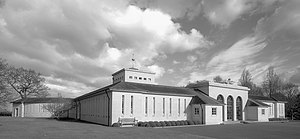Air Forces Memorial: Difference between revisions
Cloptonson (talk | contribs) →Notable Commemoratees: added Hilary Hood |
Cloptonson (talk | contribs) →Notable Commemoratees: added Vernon Keogh |
||
| Line 58: | Line 58: | ||
*Wing Commander [[Paddy Finucane|Brendan (Paddy) Finucane]], flying ace |
*Wing Commander [[Paddy Finucane|Brendan (Paddy) Finucane]], flying ace |
||
*Squadron Leader [[Hilary Hood]], Battle of Britain pilot casualty |
*Squadron Leader [[Hilary Hood]], Battle of Britain pilot casualty |
||
*Pilot Officer [[Vernon Keogh|Vernon ('Shorty')Keogh]], American RAF Battle of Britain pilot |
|||
*Flight Lieutenant [[Eric Lock]], flying ace |
*Flight Lieutenant [[Eric Lock]], flying ace |
||
*Pilot Officer [[Willie McKnight|William (Willie) McKnight]], Canadian flying ace |
*Pilot Officer [[Willie McKnight|William (Willie) McKnight]], Canadian flying ace |
||
Revision as of 15:47, 16 November 2014
| Air Forces Memorial, Runnymede | |
|---|---|
| Commonwealth War Graves Commission | |
 Showing portico entrance, look-out wing and astral crown surmounting the central chapel. | |
| For Commonwealth Air Forces dead of World War II with no known grave | |
| Unveiled | 17 October 1953 by HM Queen Elizabeth II |
| Location | 51°26′16″N 0°33′54″W / 51.4378°N 0.5650°W near Egham Surrey England |
| Designed by | Edward Maufe |
| Commemorated | Over 20,000 Commonwealth Air Forces personnel including those with acting RAF, AuxAF or WAAF rank such as SOE operatives |
The Air Forces Memorial, or Runnymede Memorial, in Englefield Green, near Egham, Surrey, England is a memorial dedicated to some 20,456 men and women from air forces of the British Empire who were lost in air and other operations during World War II.[1] Those recorded have no known grave anywhere in the world, and many were lost without trace. The name of each of these airmen and airwomen is engraved into the stone walls of the memorial, according to country and squadron.
Design
The memorial was designed by Sir Edward Maufe with sculpture by Vernon Hill. The engraved glass and painted ceilings were designed by John Hutton, and the poem engraved on the gallery window was written by Paul H Scott. It was the first post-World War II building to be listed for architectural merit.[2]
The roof of the memorial looks over the River Thames and Runnymede Meadow, where the Magna Carta was sealed by King John in 1215. Most of north, west, and central London can be seen to the right from the viewpoint; such monuments as the London Eye and the arch of Wembley Stadium are visible on clear days. Windsor Castle and the surrounding area can be seen to the left.
-
Air Forces Memorial
-
Air Forces Memorial
-
Air Forces Memorial
-
Air Forces Memorial
-
Air Forces Memorial
-
Air Forces Memorial
-
Air Forces Memorial
-
Air Forces Memorial
-
Air Forces Memorial
-
One of eighteen bronze sculptures on the main doors of the Air Forces Memorial
-
Air Forces Memorial Runnymede Entrance Gates & Monument Front Aspect
-
Image showing lay out of inscriptions by year nationality and rank
-
Memorial cloister with remembrance stone before the central chapel surmounted by the Astral Crown
-
Air Forces Memorial Runnymede England - example coat of arms of the Commonwealth Nations of the commemorated
-
Air Forces Memorial Runnymede England - View of portico from chapel & showing lions passant in door
Location
The memorial is on Coopers Hill Lane, Englefield Green, next to the former Runnymede campus of Brunel University and Kingswood Hall of Royal Holloway, University of London since 1965 when it was converted from a convent.
For location map, showing its proximity to other Runnymede memorials, see Runnymede.
Status
It is a Grade II* listed building and was completed in 1953.
Notable Commemoratees
- Flight Lieutenant Howard Peter Blatchford, Canadian Battle of Britain veteran pilot
- Flying Officer David Moore Crook, fighter pilot[3]
- Flight Lieutenant Arthur ('Art') Donahue, American RAF Flying ace, author
- Flight Lieutenant John Dundas, flying ace[4]
- Wing Commander Brendan (Paddy) Finucane, flying ace
- Squadron Leader Hilary Hood, Battle of Britain pilot casualty
- Pilot Officer Vernon ('Shorty')Keogh, American RAF Battle of Britain pilot
- Flight Lieutenant Eric Lock, flying ace
- Pilot Officer William (Willie) McKnight, Canadian flying ace
- Wing Commander John Dering Nettleton, VC recipient[5]
- Pilot Officer Esmond Romilly, anti-fascist writer[6]
- Pilot Officer Derek Teden, England rugby international.[7]
- Wing Commander Alois Vasatko, Czech flying ace[8]
- Assistant Section Officer Noor Inayat Khan, GC recipient, SOE agent
References
- ^ http://www.thecanadianencyclopedia.com/index.cfm?PgNm=TCE&Params=A1ARTA0009128 Canadian Encyclopedia Monuments, World Wars I and II
- ^ Runnymede Memorial. Commonwealth War Graves Commission. Retrieved 23 Aug 2012.
- ^ "Commonwealth War Graves Commission - Casualty Details". Commonwealth War Graves Commission. Retrieved 2007-11-21.
- ^ [1]CWGC Casualty Record, John Charles Dundas
- ^ [2]Burial locations of VC holders lost or buried at sea.
- ^ [3]CWGC Casualty Record, Esmond Mark David Romilly.
- ^ [4]CWGC Casualty Record, Derek Edmund Teden
- ^ [5]CWGC Casualty Record, Alois Vasatko.















